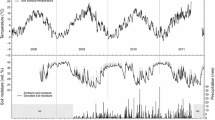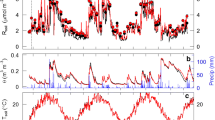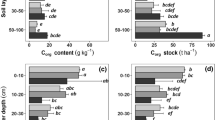Abstract
The aspen free-air CO2 and O3 enrichment (FACTS II–FACE) study in Rhinelander, Wisconsin, USA, is designed to understand the mechanisms by which young northern deciduous forest ecosystems respond to elevated atmospheric carbon dioxide (CO2) and elevated tropospheric ozone (O3) in a replicated, factorial, field experiment. Soil respiration is the second largest flux of carbon (C) in these ecosystems, and the objective of this study was to understand how soil respiration responded to the experimental treatments as these fast-growing stands of pure aspen and birch + aspen approached maximum leaf area. Rates of soil respiration were typically lowest in the elevated O3 treatment. Elevated CO2 significantly stimulated soil respiration (8–26%) compared to the control treatment in both community types over all three growing seasons. In years 6–7 of the experiment, the greatest rates of soil respiration occurred in the interaction treatment (CO2 + O3), and rates of soil respiration were 15–25% greater in this treatment than in the elevated CO2 treatment, depending on year and community type. Two of the treatments, elevated CO2 and elevated CO2 + O3, were fumigated with 13C-depleted CO2, and in these two treatments we used standard isotope mixing models to understand the proportions of new and old C in soil respiration. During the peak of the growing season, C fixed since the initiation of the experiment in 1998 (new C) accounted for 60–80% of total soil respiration. The isotope measurements independently confirmed that more new C was respired from the interaction treatment compared to the elevated CO2 treatment. A period of low soil moisture late in the 2003 growing season resulted in soil respiration with an isotopic signature 4–6‰ enriched in 13C compared to sample dates when the percentage soil moisture was higher. In 2004, an extended period of low soil moisture during August and early September, punctuated by a significant rainfall event, resulted in soil respiration that was temporarily 4–6‰ more depleted in 13C. Up to 50% of the Earth’s forests will see elevated concentrations of both CO2 and O3 in the coming decades and these interacting atmospheric trace gases stimulated soil respiration in this study.






Similar content being viewed by others
References
Ainsworth EA, Long SP (2005) What have we learned from 15 years of free-air CO2 enrichment (FACE)? A meta-analytic review of the responses of photosynthesis, canopy properties and plant production to rising CO2. New Phytol 163:351–372
Albritton DL, Meira Filho LG, Cubasch U, Da X, Ding Y, Griggs DJ, Hewitson B, Houghton JT, Isaksen I, Karl T, McFarland M, Meleshko VP, Mitchell JFB, Noguer M, Nyenzi BS, Oppenheimer M, Penner JE, Pollonais S, Stocker T, Trenberth KE (2001) Technical summary. In: Houghton JT, Ding Y, Griggs DJ, Noguer M, van der Linden PJ, Xiasou D (eds) Climate change 2001: the scientific basis. Cambridge University Press, Cambridge, pp 21–83
Anderson CP (2003) Source-sink balance and carbon allocation belowground in plants exposed to ozone. New Phytol 157:213–228
Andrews JA, Harrison KG, Matamala R, Schlesinger WH (1999) Separation of root respiration from total soil respiration using carbon-13 labelling during free-air carbon dioxide enrichment (FACE). Soil Sci Soc Am J 63:1429–1435
Burton AJ, Pregitzer KS, Zogg GP, Zak DR (1998) Drought reduces root respiration in sugar maple forests. Ecol Appl 8:771–778
Cerling TE, Solomom DK, Quade J, Bowman JR (1991) On the isotopic composition of carbon in soil carbon dioxide. Geochim Cosmochim Acta 55:3403–3405
Coleman MD, Dickson RE, Isebrands JG, Karnosky DF (1996) Root growth and physiology of potted and field-grown trembling aspen exposed to ozone. Tree Physiol 16:145–152
Curtis PS, Wang X (1998) A meta-analysis of elevated CO2 effects on woody plant mass, form, and physiology. Oecologia 113:299–313
Davidson GR (1995) The stable isotopic composition and measurement of carbon in soil CO2. Geochim Cosmochim Acta 59:2485–2489
Dickson RE, Lewin KF, Isebrands JG, Coleman MD, Heilman WE, Riemenschneider DE, Sober J, Host GE, Hendrey GR, Pregitzer KS, Karnosky DF (2000) Forest atmosphere carbon transfer storage-II (FACTS II)—The aspen free-air CO2 and O3 enrichment (FACE) project in an overview. USDA Forest Service North Central Experiment Station. General Tech Rep NC-214, pp 68
Ehleringer JR, Buchmann N, Flanagan LB (2000) Carbon isotope ratios in belowground carbon cycle processes. Ecol Appl 10:412–422
Ekblad A, Högberg P (2001) Natural abundance of 13C in CO2 respired from forest soils reveals speed of link between tree photosynthesis and root respiration. Oecologia 127:305–308
Felzer B, Kicklighter D, Melillo J, Wang C, Zhuang Q, Prinn R (2004) Effects of ozone on net primary production and carbon sequestration in the conterminous United States using a biogeochemistry model. Tellus 54B:230–248
Fowler D, Flechard C, Skiba U, Coyle M, Cape JN (1998) The atmospheric budget of oxidized nitrogen and its role in ozone formation and deposition. New Phytol 139:11–23
Fowler D, Cape JN, Coyle M, Smith RI, Hjellbrekke AG, Simpson D, Derwent RG, Johnson CE (1999) Modeling photochemical oxidant formation, transport, deposition, and exposure of terrestrial ecosystems. Environ Pollut 100:43–55
Gorissen A, van Veen JA (1988) Temporary disturbance of translocation of assimilates in Douglas-firs caused by low levels of ozone and sulfur dioxide. Plant Physiol 88:559–563
Grulke NW, Anderson CP, Hogsett WE (2001) Seasonal changes in above- and belowground carbohydrate concentration of ponderosa pine along a pollution gradient. Tree Physiol 21:173–181
Högberg P, Nordgren A, Buchmann N, Taylor AFS, Ekblad A, Högberg MN, Nyberg G, Ottosson-Löfvenius M, Read DJ (2001) Large-scale forest girdling shows that currect photosynthesis drives soil respiration. Nature 411:789–792
Högberg P, Nordgren A, Ågren GI (2002) Carbon allocation between tree root growth and root respiration in boreal pine forest. Oecologia 132:579–581
Janssens IA, Kowalski AS, Longdoz B, Ceulemans R (2000) Assessing forest soil CO2 efflux: an in situ comparison of four techniques. Tree Physiol 20:23–32
Karnosky DF, Zak DR, Pregitzer KS, Awmack CS, Bockheim JG, Dickson RE, Hendrey GR, Host GE, King JS, Kopper BJ, Kruger EL, Kubiske ME, Lindroth RL, Mattson WJ, McDonald EP, Noormets A, Oksanen E, Parsons WFJ, Percy KE, Podila GK, Riemenschneider DE, Sharma P, Sober A, Sober J, Jones WS, Anttonen S, Vapaavuori E, Isebrands JG (2003) Tropospheric O3 moderates responses of temperate hardwood forests to elevated CO2: A synthesis of molecular to ecosystem results from the Aspen FACE project. Funct Ecol 17:287–307
Karnosky DF, Pregitzer KS, Zak DR, Kubiske ME, Hendry GR, Weinstein D, Nosal M, Percy KE (2005) Scaling ozone responses of forest trees to the ecosystem level in a changing climate. Plant Cell Environ 28:965–981
Kasurinen A, Kokko-Gonzales P, Riikonen J, Vapaavuori E, Holopainen T (2004) Soil CO2 efflux of two silver birch clones exposed to elevated CO2 and O3 levels during three growing seasons. Global Change Biol 10:1654–1665
King JS, Pregitzer KS, Zak DR, Karnosky DF, Isebrands JG, Dickson RE, Hendrey GR, Sober J (2001) Fine root biomass and fluxes of soil carbon in young stands of paper birch and trembling aspen as affected by elevated atmospheric CO2 and tropospheric O3. Oecologia 128:237–250
King JS, Hanson PJ, Bernhardt E, DeAngelis P, Norby RJ, Pregitzer KS (2004) A multi-year synthesis of soil respiration responses to elevated atmospheric CO2 from four forest FACE experiments. Global Change Biol 10:1027–1042
King JS, Kubiske ME, Pregitzer KS, Hendrey GR, Giardina CP, McDonald EP, Quinn VA, Karnosky DF (2005) Tropospheric O3 compromises net primary production in young stands of trembling aspen, paper birch, and sugar maple in response to elevated atmospheric CO2. New Phytol (in press)
Knohl A, Werner RA, Brand WA, Buchmann N (2005) Short-term variations in the δ13C of ecosystem respiration reveals link between assimilation and respiration in a deciduous forest. Oecologia 142:70–82
Krupa S, McGrath MT, Andersen CP, Booker FL, Burkey KO, Chappelka AH, Chevone BI, Pell EJ, Zilinskas BA (2000) Ambient ozone and plant health. Plant Dis 85:4–12
Loya WM, Pregitzer KS, Karberg NJ, King JS, Giardina CP (2003) Reduction of soil carbon formation by tropospheric ozone under increased carbon dioxide levels. Nature 425:705–707
Manning WJ, Feder WA, Papia PM, Perkins I (1971) Influence of foliar ozone injury on root development and root surface fungi of pinto bean plants. Environ Pollut 1:305–312
Matamala R, Gonzàlez-Meler MA, Jastrow JD, Norby RJ, Schlesinger WH (2003) Impacts of fine root turnover on forest NPP and soil C sequestration potential. Science 21:1385–1387
McDowell NG, Bowling DR, Bond BJ, Irvine J, Law BE, Anthoni P, Ehleringer JR (2004) Response of carbon isotopic content of ecosystem, leaf, and soil respiration to meteorological and physiological driving factors in a Pinus ponderosa ecosystem. Global Biogeochem Cycles 18:GB1013
Norby RJ, Ledford J, Reilly CD, Miller NE, O’Neill EG (2004) Fine-root production dominates response of a deciduous forest to atmospheric CO2 enrichment. Proc Natl Acad Sci USA 101:9689–9693
Pataki DE, Ehleringer JR, Flanagan LB, Yakir D, Bowling DR, Still CJ, Buchmann N, Kaplan JO, Berry JA (2003) The application and interpretation of Keeling plots in terrestrial carbon cycle research. Global Biogeochem Cycles 17:22-1–22-14
Percy KE, Awmack CS, Lindroth RL, Kubiske ME, Kopper BJ, Isebrands JG, Pregitzer KS, Hendrey GR, Dickson RE, Zak DR, Oksanen E, Sober J, Harrington R, Karnosky DF (2002) Altered performance of forest pests under CO2- and O3-enriched atmospheres. Nature 420:403–407
Phillips DL, Gregg JW (2001) Uncertainities in source partitioning using stable isotopes. Oecologia 127:171–170
Pregitzer KS, Zak DR, Curtis PS, Kubiske ME, Teeri JA, Vogel CS (1995) Atmospheric CO2, soil nitrogen and fine root turnover. New Phytol 129:579–585
Pregitzer KS, Zak DR, Maziasz J, DeForest J, Curtis PS, Lussenhop J (2000a) Interactive effects of atmospheric CO2 and Soil-N availability on fine roots of Populus tremuloides. Ecol Appl 10:18–33
Pregitzer KS, King JS, Burton AJ (2000b) Responses of fine roots to temperature with emphasis on trees. New Phytol 147:105–115
Rennenberg H, Herschbach C, Poole A (1996) Consequences of air pollution on shoot-root interactions. J Plant Physiol 148:296–301
Rogers HH, Runion GB, Krupa SV (1994) Plant responses to atmospheric CO2 enrichment with emphasis on roots and the rhizosphere. Environ Pollut 83:155–189
Steinmann K, Siegwolf RTW, Saurer M, Körner C (2004) Carbon fluxes to the soil in a mature temperate forest assessed by 13C isotope tracing. Oecologia 141:489–501
Tingey DT, Phillips DL, Johnson MG (2000) Elevated CO2 and conifer roots: effects on growth, life span and turnover. New Phytol 147:87–103
Xu C, Lin G, Griffin K, Sambrotto RN (2004) Leaf respiratory CO2 is 13C-enriched relative to leaf organic components in five species of C3 plants. New Phytol 163:499–505
Zak DR, Pregitzer KS, King JS, Holmes WE (2000) Elevated atmospheric CO2, fine roots and the response of soil microorganisms: a review and hypothesis. New Phytol 147:201–222
Acknowledgements
Noah Karberg, Jennifer Eikenberry, Angela Piket, Andy Burton and Robin Johnson, along with 12 undergraduate students, contributed to the field measurements. Tom Boutton and Diane Pataki assisted in the interpretation of 13C data. This research was supported by the US Department of Energy–Office of Biological and Environmental Research through its Program for Ecosystem Research, the USDA Forest Service (Northern Global Change and North Central Research Station), National Science Foundation (DEB, DBI/MRI), and Michigan Technological University. G. Hendry, K. Lewin, and J. Nagey from Brookhaven National Laboratory and D. Karnosky and J. Sober of Michigan Technological University have been instrumental to the successful establishment and implementation of this complicated field experiment.
Author information
Authors and Affiliations
Corresponding author
Additional information
Communicated by Jim Ehleringer
Rights and permissions
About this article
Cite this article
Pregitzer, K., Loya, W., Kubiske, M. et al. Soil respiration in northern forests exposed to elevated atmospheric carbon dioxide and ozone. Oecologia 148, 503–516 (2006). https://doi.org/10.1007/s00442-006-0381-8
Received:
Accepted:
Published:
Issue Date:
DOI: https://doi.org/10.1007/s00442-006-0381-8




